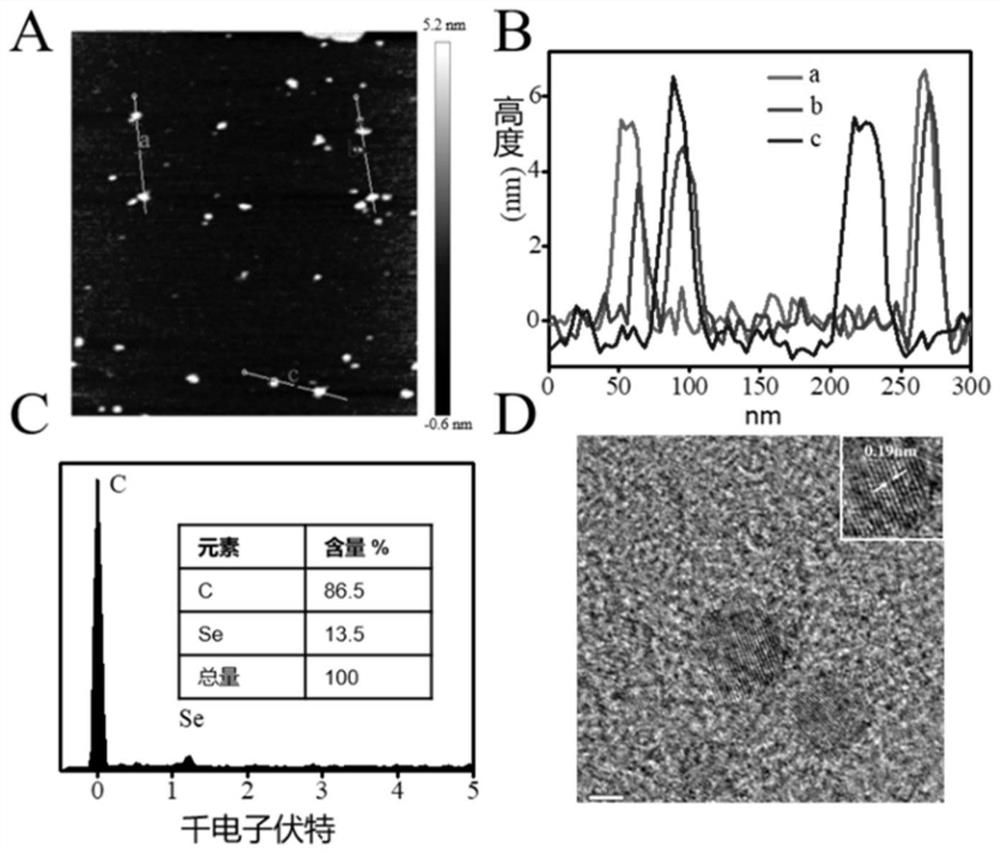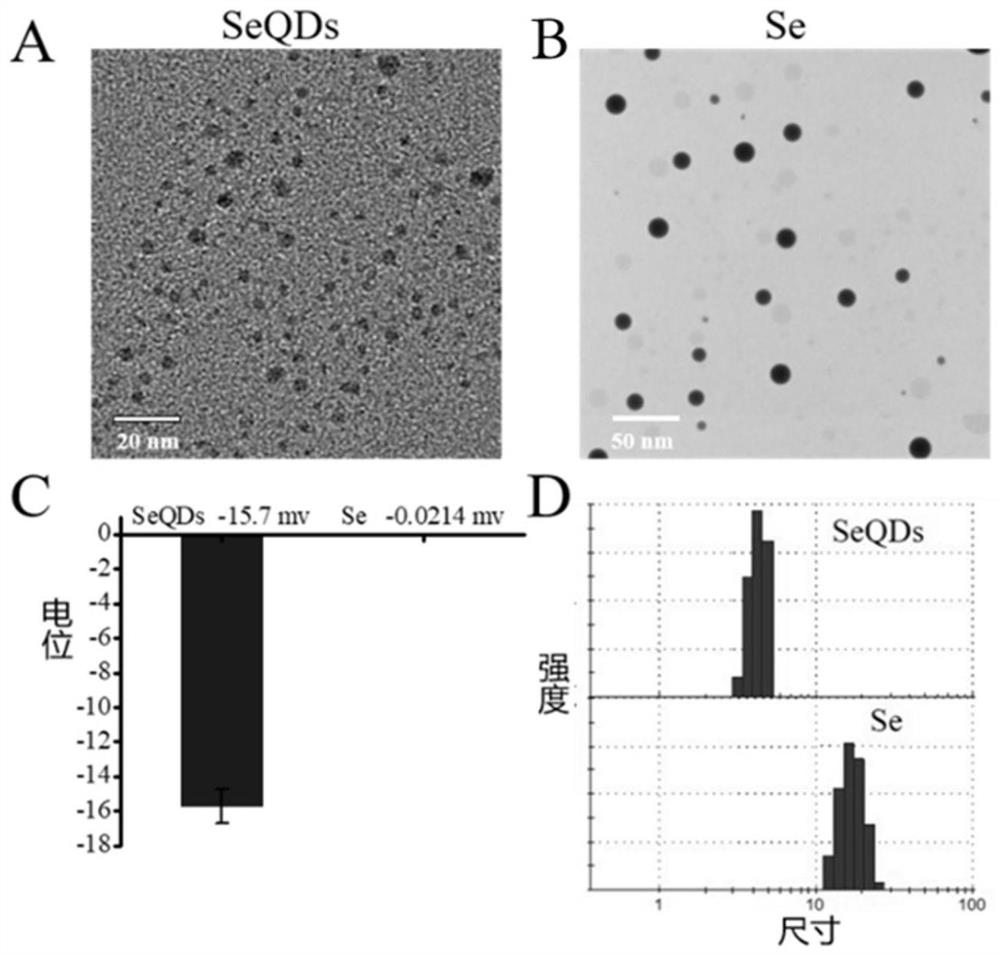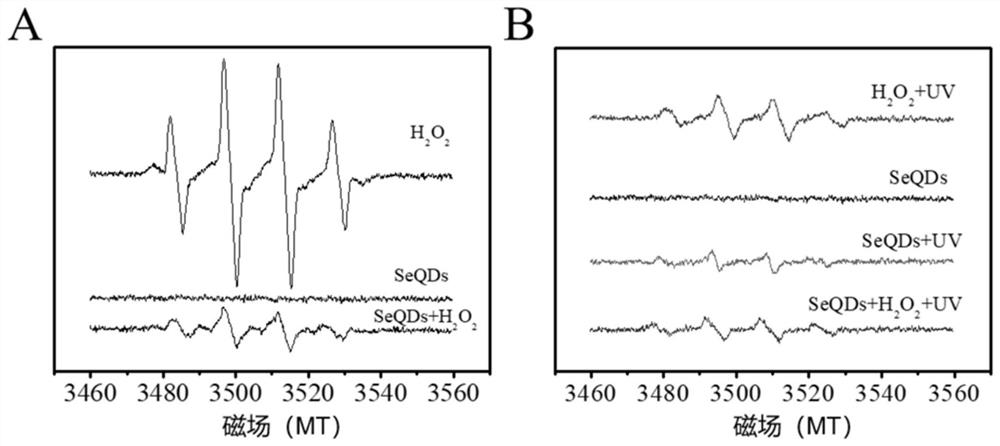Preparation of traceable ultra-small nano-selenium and its application in Alzheimer's disease
An Alzheimer's disease, ultra-small technology, applied in the direction of nanotechnology, nanotechnology, in vivo test preparations, etc., can solve the problem that diagnostic technology cannot meet the needs of efficient and accurate detection, difficult to describe and measure, and no Al Alzheimer's disease and other problems, achieve the effect of inhibiting spontaneous aggregation, reducing amyloid plaques, and overcoming premature release
- Summary
- Abstract
- Description
- Claims
- Application Information
AI Technical Summary
Problems solved by technology
Method used
Image
Examples
Embodiment 1
[0050] Embodiment 1: Preparation of ultra-small nano-selenium modified by rhodamine
[0051] (1) Synthesis of ultra-small nano-selenium:
[0052] Add 10 mg of niobium selenide into 100 ml of distilled water, and keep stirring for 12 hours to obtain a uniformly dispersed solution. The resulting solution was added to a lined high-temperature reactor with a total volume of 150 ml, then the high-temperature reactor was sealed, and after a constant temperature reaction (at a temperature of 60° C.) for 4 hours, it was allowed to cool naturally to room temperature and allowed to stand for 6 hours. Then transfer the solution to a beaker and add 2mL of 40mM VC (vitamin C), stir for 10min under airtight conditions, adjust the pH to 8.0, and sonicate for 3h (pH 8.0) with a power of 250W. Afterwards, the solution was centrifuged for 15 minutes at a rotation speed of 10,000 rpm, and washed three times with absolute ethanol and water respectively. The resulting sample was dispersed into 3...
Embodiment 2
[0060] Example 2: Control Nano-Characterization
[0061] For comparison, normal nano-selenium (prepared in Example 1(3)①) was prepared to study the effect of particle size on the permeability of the blood-brain barrier. The size distribution and zeta potential of the nanoparticles were measured by a Malvern Zetasizer Nanzo ZS nanoparticle sizer. The results show that the particle diameters of nano-selenium and ultra-small nano-selenium (prepared in Example 1 (1)) in PBS buffer solution with pH=7.4 are 20nm and 4nm, respectively. see results figure 2 : The different potential and particle size changes indicate that according to different synthesis methods, we have successfully prepared two different sizes of nano-selenium.
Embodiment 3
[0062] Example 3: Ultra-small nano-selenium scavenging effect on free radicals in vitro
[0063] Detect the ultra-small nano-selenium (SeQDs) prepared in Example 1 (1) to the scavenging effect of excess free radicals, the specific process is as follows: SeQDs is added to H 2 o 2 Medium (SeQDs+H 2 o 2 ), the electron spin resonance (ESR) spectrum of the final reactant (i.e., DEMPO / COH adduct) was collected after 3 min of incubation, while the SeQDs alone and the H 2 o 2 is the control; among them, H 2 o 2 The final concentrations of SeQDs and SeQDs were 5 mM and 1 mg / mL, respectively. At the same time, adding SeQDs to H 2 o 2 After UV irradiation (SeQDs+H 2 o 2 +UV), with SeQDs plus UV irradiation (SeQDs+UV), H 2 o 2 UV irradiation (H 2 o 2 +UV), and SeQDs as controls. see results image 3 : Experimental results show that ultra-small nano-selenium can effectively eliminate H 2 o 2 Oxidation produces strength.
PUM
| Property | Measurement | Unit |
|---|---|---|
| particle diameter | aaaaa | aaaaa |
Abstract
Description
Claims
Application Information
 Login to View More
Login to View More - R&D
- Intellectual Property
- Life Sciences
- Materials
- Tech Scout
- Unparalleled Data Quality
- Higher Quality Content
- 60% Fewer Hallucinations
Browse by: Latest US Patents, China's latest patents, Technical Efficacy Thesaurus, Application Domain, Technology Topic, Popular Technical Reports.
© 2025 PatSnap. All rights reserved.Legal|Privacy policy|Modern Slavery Act Transparency Statement|Sitemap|About US| Contact US: help@patsnap.com



